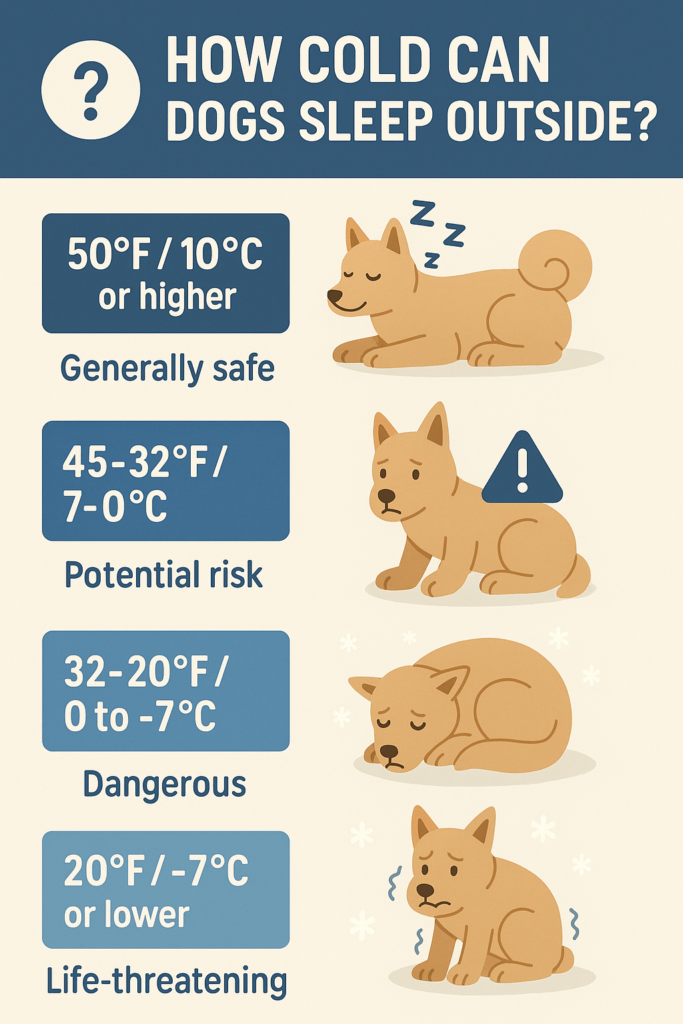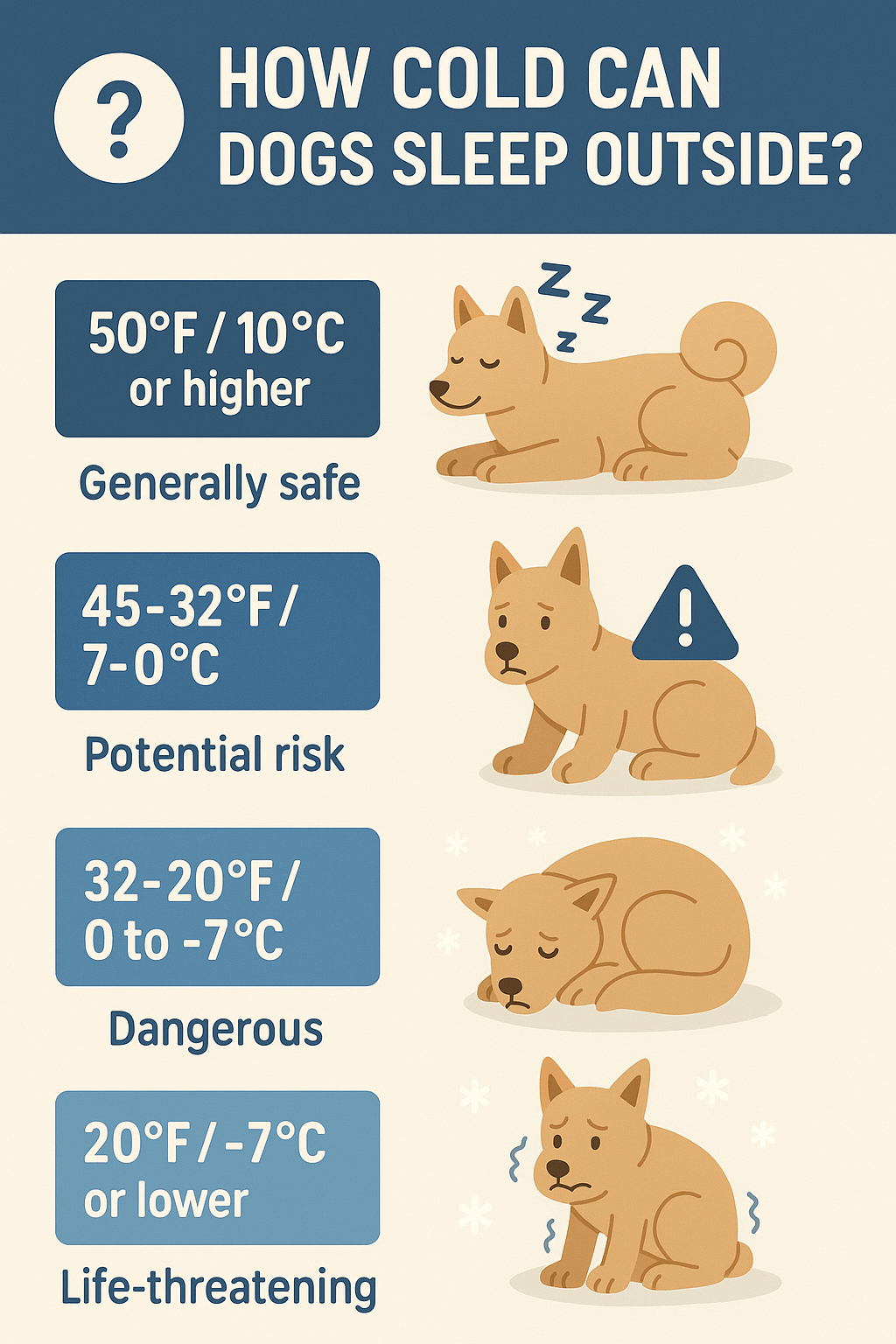How Cold Can a Dog Sleep Outside?
Many dog owners wonder whether it’s safe for their furry companions to sleep outside in cold weather. While some breeds are naturally equipped to handle chilly temperatures, others may struggle to stay warm and comfortable. Understanding your dog’s needs, breed-specific tolerances, and the risks associated with cold exposure is essential to ensuring their safety and well-being. In this blog post, we’ll explore how cold is too cold, what factors influence a dog’s ability to sleep outside, and how you can provide proper care during colder months. Let’s dive into the details to help you make informed decisions about your dog’s outdoor sleeping arrangements.
Expert Insight: How Coat Type Affects Cold Tolerance
“Dogs with thick, double-layered coats tend to be the most cold-tolerant (think Siberian Huskies, Newfoundlands, and Samoyeds). Many of these breeds originated in northern climates and have attributes that allow them to thrive when temperatures drop.
However, dogs with exceptionally thin coats, like the Basenji and Xoloitzcuintli, may suffer in the cold and tend to do better when it’s warmer outside. If your dog has a very thin coat, you will want to consider bundling them up before heading outside.”
Factors That Determine How Cold Is Too Cold for Dogs
Not all dogs are created equal when it comes to tolerating cold weather. Several factors play a role in determining whether your dog can safely sleep outside in low temperatures.
Breed and Coat Type:
Breeds like Huskies or Malamutes have thick double coats that insulate them against freezing temperatures, while short-haired breeds like Greyhounds are more vulnerable to the cold.Age and Health Condition:
Puppies, senior dogs, and those with health issues such as arthritis or respiratory problems are less able to regulate their body temperature in cold weather.Size and Body Composition:
Smaller dogs lose heat faster than larger dogs due to their higher surface area-to-body mass ratio, making them more susceptible to hypothermia.Acclimatization to the Environment:
Dogs accustomed to cold climates are better equipped to handle lower temperatures compared to those used to warmer environments.Shelter Quality:
A well-insulated, windproof shelter can make a significant difference in keeping your dog warm and safe during cold nights.
Considering these factors helps you assess whether your dog is suited to sleeping outside in cold weather and what precautions you need to take.

Signs Your Dog Is Too Cold
Recognizing the signs of discomfort or distress in cold weather is crucial for protecting your dog from potential harm. Here are some indicators that your dog may be struggling with the cold.
Shivering or Trembling:
Shivering is one of the first signs that your dog is losing body heat and trying to generate warmth.Lethargy or Sluggish Behavior:
If your dog seems unusually tired or unwilling to move, it could indicate that they’re too cold to function normally.Curling Up Excessively:
Dogs often curl up to conserve heat, but excessive curling may signal that they’re struggling to stay warm.Whining or Vocalizing Distress:
Some dogs will whine or bark to communicate their discomfort in cold conditions.Cold Ears or Paws:
Feeling your dog’s ears or paws can give you an idea of their overall body temperature—if these areas feel icy, your dog is likely too cold.
Being vigilant about these signs allows you to intervene promptly and prevent complications like hypothermia.
Check this guide 👉How Long Does a Dog Cold Last? Best 7 Expert Tips!
Check this guide 👉Dog Cold vs Kennel Cough: Best 7 Expert Tips!
Check this guide 👉Why Is My Dogs Mouth Cold? Best 7 Expert Tips!
Ways to Keep Your Dog Warm Outside | Risks of Cold Weather Exposure |
|---|---|
Provide a heated dog bed | Risk of hypothermia |
Use insulated blankets or jackets | Frostbite on extremities like paws or ears |
Build a windproof and insulated shelter | Increased stress or anxiety |
Offer fresh water to prevent dehydration | Weakened immune system |
Limit time spent outdoors in extreme cold | Potential behavioral changes |
Best Practices for Keeping Your Dog Safe in Cold Weather
If your dog must sleep outside during colder months, following best practices ensures their comfort and safety. These tips can make a world of difference in harsh conditions.
Provide Adequate Shelter:
Ensure your dog has access to a dry, insulated shelter raised off the ground to protect them from wind, rain, and snow.Use Heated Accessories:
Heated dog beds or mats can help maintain a consistent temperature inside the shelter.Dress Your Dog Appropriately:
For short-haired or small breeds, consider using a waterproof and insulated dog jacket to provide extra warmth.Check Their Water Supply Regularly:
Cold temperatures can freeze water bowls, so use heated bowls or replace water frequently to ensure hydration.Monitor Temperature Closely:
Avoid leaving your dog outside if temperatures drop below freezing or if wind chill makes conditions harsher than expected.
Implementing these practices minimizes the risks associated with cold weather and keeps your dog healthy and happy.
Breeds Best Suited for Sleeping Outside in Cold Weather
Certain dog breeds are naturally adapted to withstand colder climates, making them better candidates for sleeping outside during winter. However, even these breeds require proper care and shelter.
Siberian Husky:
Known for their thick double coat, Huskies thrive in cold environments and rarely show signs of discomfort in freezing temperatures.Alaskan Malamute:
This breed has incredible endurance in cold weather, thanks to its robust build and dense fur.Bernese Mountain Dog:
Originally bred for snowy alpine regions, Bernese Mountain Dogs handle cold weather exceptionally well.Saint Bernard:
With their large size and thick coat, Saint Bernards are built for snowy conditions and can tolerate low temperatures effectively.Samoyed:
Samoyeds were bred to live in Arctic climates, making them one of the most cold-tolerant breeds available.
While these breeds are naturally suited for cold weather, they still need adequate shelter and care to remain safe and comfortable.
Common Mistakes to Avoid When Leaving Dogs Outside
Even well-intentioned pet owners can make mistakes when leaving their dogs outside in cold weather. Avoiding these errors ensures your dog’s safety and comfort.
Underestimating the Wind Chill Factor:
Wind can significantly lower the perceived temperature, making it feel much colder than the thermometer reads.Neglecting Shelter Insulation:
A poorly insulated shelter offers little protection from freezing temperatures and drafts.Leaving Wet Dogs Outside:
Wet fur loses its insulating properties, increasing the risk of hypothermia. Always dry your dog before letting them outside.Ignoring Hydration Needs:
Dogs can become dehydrated in cold weather just as easily as in hot weather. Ensure fresh water is always available.Assuming All Breeds Are Equal:
Not all dogs are built for cold weather—some require special accommodations regardless of their size or coat type.
By avoiding these mistakes, you can create a safer environment for your dog during colder months.
How to Prepare Your Dog’s Shelter for Winter
A well-prepared shelter is key to keeping your dog warm and protected during cold nights. Follow these steps to winterize their outdoor space.
Insulate the Shelter Walls:
Use materials like foam boards or straw to line the walls and floor, providing an extra layer of warmth.Elevate the Shelter Off the Ground:
Raising the shelter prevents cold ground from leaching heat and reduces moisture buildup.Add a Flap Door:
Installing a flexible flap door helps block wind and snow while allowing your dog easy access.Use Bedding Wisely:
Opt for straw or cedar shavings instead of blankets, as these materials resist moisture and retain heat better.Check for Drafts Regularly:
Inspect the shelter periodically to ensure there are no gaps where cold air can seep in.
Preparing your dog’s shelter properly ensures they have a cozy retreat during the coldest nights.
Indoor Alternatives for Cold Weather Care
If outdoor sleeping isn’t ideal for your dog during winter, there are plenty of indoor alternatives to keep them safe and comfortable.
Create a Designated Indoor Space:
Set up a quiet corner with a soft bed and familiar items to make your dog feel at home.Use Pet Gates or Crates:
Confine your dog to a specific area to prevent accidents while still giving them freedom to move around.Introduce Them Gradually to Indoors:
If your dog isn’t used to being inside, ease the transition by spending time together and rewarding calm behavior.Maintain a Routine:
Stick to regular feeding, walking, and bathroom schedules to minimize stress caused by the change in environment.Provide Mental Stimulation:
Engage your dog with toys, puzzles, or training sessions to keep them entertained and prevent boredom indoors.
These indoor options offer safe and enjoyable alternatives for dogs who aren’t suited to sleeping outside in cold weather.
Frequently Asked Questions About Dogs Sleeping Outside in Cold Weather
What temperature is too cold for dogs to sleep outside?
Generally, temperatures below 40°F (4°C) are risky for most dogs, while freezing temperatures (below 32°F or 0°C) are dangerous without proper shelter.
Can I leave my dog outside overnight in winter?
It depends on the breed, shelter quality, and temperature. Always prioritize your dog’s safety and bring them inside if conditions worsen.
How can I tell if my dog is too cold?
Look for signs like shivering, lethargy, whining, or cold extremities. Address these symptoms immediately to prevent further issues.
Do dogs need blankets in cold weather?
Yes, especially for short-haired or small breeds. Blankets add an extra layer of insulation and help retain body heat.
Can cold weather make my dog sick?
Prolonged exposure to cold can weaken your dog’s immune system, increasing the risk of illnesses like hypothermia or respiratory infections.
Prioritizing Your Dog’s Comfort and Safety in Cold Weather
Deciding whether your dog can sleep outside in cold weather requires careful consideration of their breed, health, and environmental conditions. While some dogs are naturally equipped to handle chilly temperatures, others need additional support to stay warm and safe. By providing proper shelter, monitoring their behavior, and understanding their unique needs, you can ensure your dog remains healthy and happy throughout the winter. Remember, no matter how resilient your dog may seem, their well-being always comes first—so don’t hesitate to bring them indoors when in doubt.
Understanding Cryptosporidium in Cats: Best 7 Expert Tips! – Spot symptoms, treat safely, and stop parasite spread in your home.
Understanding Cryptosporidium in Dogs: Best 7 Expert Tips! – Learn symptoms, treatment & prevention for this stubborn gut parasite.
Understanding Syringomyelia in Cats: Best 7 Expert Tips! – Recognize signs, manage pain, and support your cat’s neurological health with vet-backed guidance.
Understanding Syringomyelia in Dogs: Best 7 Expert Tips! – Expert insights on symptoms, MRI diagnosis, pain management & quality of life.





